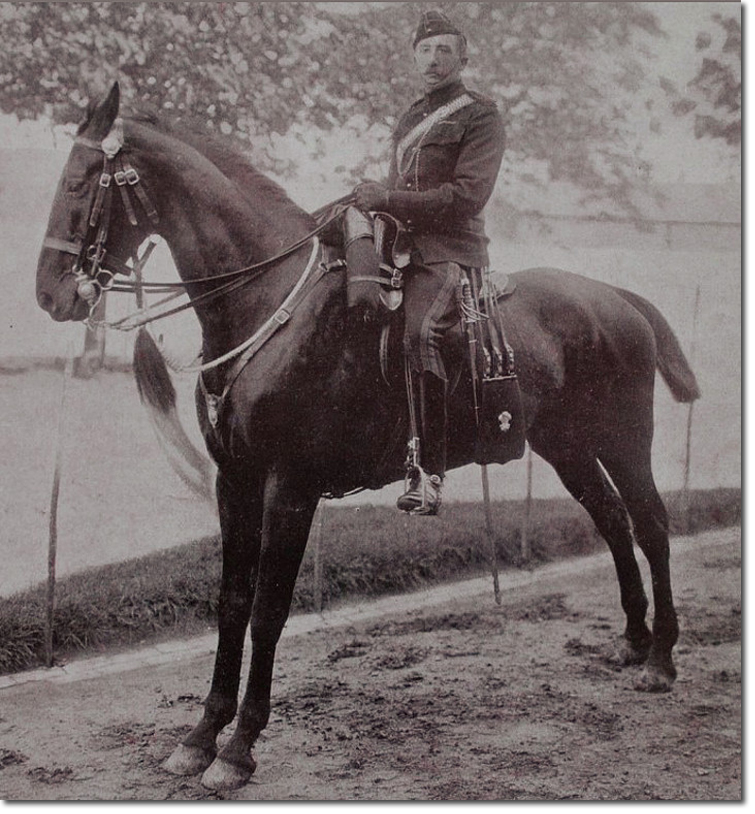|
|


|
|
Arthur Hughes-Onslow was born on 24 Aug 1862 at Alton Albury, Girvan, Ayrshire. He was the son of Henry John Hughes-Onslow and Judith Charlotte Barras. Arthur inherited the family home as he was the eldest of 5 children.
He was initially commissioned as a lieutenant in the 5th Lancers on 10 May 1882 but did not join that regiment. He obtained a transfer to the 10th Hussars on 6 Sep 1882 and joined them at Lucknow on 24 Dec 1882. He fought at El Teb and Tamai, and was in the reconnaissance at Tamanieb. He was promoted to captain on 4 Jan 1890 and given command of B Troop. He was a well respected but strict leader of men. According to his biography in the regimental gazette of April 1914, ‘Any slacker or shirker who came under his control would be quickly taught that his best policy was to do with all his might whatsoever Major Onslow found for him to do.’ As a result the Troops or squadrons under his command were invariably the most efficient.
He was promoted to major on 16 Feb 1898, commanding A Squadron which incorporated A and B Troops. His firm leadership came into its own when his squadron was on the Transport Ismore that was wrecked off the coast of South Africa. At Stellenbosch, as most of the horses had been sadly lost at sea in the wreck, his men were issued with Argentine horses which needed to be trained and subdued. Major Onslow took it upon himself to break one of the more difficult horses and sustained a back injury as a result. This did not slow him down as his squadron went on to distinguish themselves at Colesberg and then at the battle of Paardeburg on 17 Feb 1900. After a forced march as part of the 2nd Cavalry Brigade, the 10th Hussars arrived just in time to head off Cronje’s army of 5,000. A Squadron raced against Nieuwenhodt’s commando to Gun Hill. The squadron made a supreme effort and gained the position which checked the Boer movement. Onslow’s men also distinguished themselves at Poplar Grove, Driefontein and in many skirmishes. But the major became ill and had to be sent home to England. When he recovered he was put in charge of the depot. He retired on 14 Jan 1903 after having served more than 20 years in the regiment. Major Onslow, known as ‘Junks’, was a keen and famous sportsman, winning many races, steeplechases and point-to-points. He was an accomplished cricketer and polo player. It seems that he was a latter-day Renaissance man as he was also a prolific and entertaining writer. In June1891 he married Annie Kathleen Whitehead. They had two children, a daughter, Dorothy and a son who was Commander Sir Geoffrey Hughes-Onslow RN who fought in both world wars. Major Onslow lived in Braunston in Rutland. He died on 17 Aug 1914 after shooting himself on the voyage across the channel to Le Havre. According to the Rutland Remembers website he was so depressed at the thought of sending horses to the Western Front where they would inevitably suffer from heavy artillery bombardment and machine-gun fire. The photo, supplied by John Fergusson, great-grandson of Major Hughes-Onslow, shows the newly promoted major mounted up on his charger in the undress uniform of the 10th Hussars c1898. |
Armed Forces | Art and Culture | Articles | Biographies | Colonies | Discussion | Glossary | Home | Library | Links | Map Room | Sources and Media | Science and Technology | Search | Student Zone | Timelines | TV & Film | Wargames